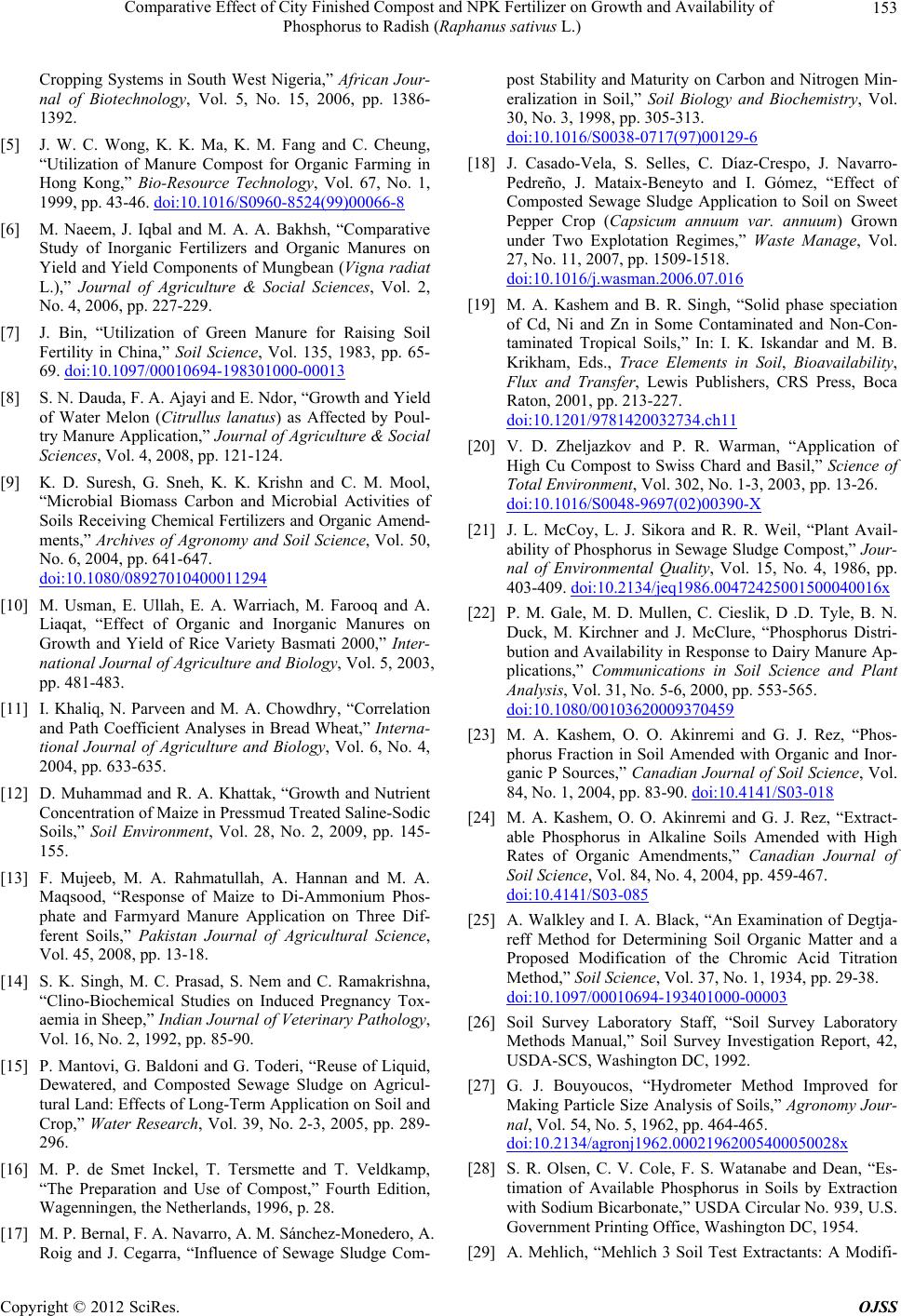
Comparative Effect of City Finished Compost and NPK Fertilizer on Growth and Availability of
Phosphorus to Radish (Raphanus sativus L.) 153
Cropping Systems in South West Nigeria,” African Jour-
nal of Biotechnology, Vol. 5, No. 15, 2006, pp. 1386-
1392.
[5] J. W. C. Wong, K. K. Ma, K. M. Fang and C. Cheung,
“Utilization of Manure Compost for Organic Farming in
Hong Kong,” Bio-Resource Technology, Vol. 67, No. 1,
1999, pp. 43-46. doi:10.1016/S0960-8524(99)00066-8
[6] M. Naeem, J. Iqbal and M. A. A. Bakhsh, “Comparative
Study of Inorganic Fertilizers and Organic Manures on
Yield and Yield Components of Mungbean (Vigna radiat
L.),” Journal of Agriculture & Social Sciences, Vol. 2,
No. 4, 2006, pp. 227-229.
[7] J. Bin, “Utilization of Green Manure for Raising Soil
Fertility in China,” Soil Science, Vol. 135, 1983, pp. 65-
69. doi:10.1097/00010694-198301000-00013
[8] S. N. Dauda, F. A. Ajayi and E. Ndor, “Growth and Yield
of Water Melon (Citrullus lanatus) as Affected by Poul-
try Manure Application,” Journal of Agriculture & Social
Sciences, Vol. 4, 2008, pp. 121-124.
[9] K. D. Suresh, G. Sneh, K. K. Krishn and C. M. Mool,
“Microbial Biomass Carbon and Microbial Activities of
Soils Receiving Chemical Fertilizers and Organic Amend-
ments,” Archives of Agronomy and Soil Science, Vol. 50,
No. 6, 2004, pp. 641-647.
doi:10.1080/08927010400011294
[10] M. Usman, E. Ullah, E. A. Warriach, M. Farooq and A.
Liaqat, “Effect of Organic and Inorganic Manures on
Growth and Yield of Rice Variety Basmati 2000,” Inter-
national Journal of Agriculture and Biology, Vol. 5, 2003,
pp. 481-483.
[11] I. Khaliq, N. Parveen and M. A. Chowdhry, “Correlation
and Path Coefficient Analyses in Bread Wheat,” Interna-
tional Journal of Agriculture and Biology, Vol. 6, No. 4,
2004, pp. 633-635.
[12] D. Muhammad and R. A. Khattak, “Growth and Nutrient
Concentration of Maize in Pressmud Treated Saline-Sodic
Soils,” Soil Environment, Vol. 28, No. 2, 2009, pp. 145-
155.
[13] F. Mujeeb, M. A. Rahmatullah, A. Hannan and M. A.
Maqsood, “Response of Maize to Di-Ammonium Phos-
phate and Farmyard Manure Application on Three Dif-
ferent Soils,” Pakistan Journal of Agricultural Science,
Vol. 45, 2008, pp. 13-18.
[14] S. K. Singh, M. C. Prasad, S. Nem and C. Ramakrishna,
“Clino-Biochemical Studies on Induced Pregnancy Tox-
aemia in Sheep,” Indian Journal of Veterinary Pathology,
Vol. 16, No. 2, 1992, pp. 85-90.
[15] P. Mantovi, G. Baldoni and G. Toderi, “Reuse of Liquid,
Dewatered, and Composted Sewage Sludge on Agricul-
tural Land: Effects of Long-Term Application on Soil and
Crop,” Water Research, Vol. 39, No. 2-3, 2005, pp. 289-
296.
[16] M. P. de Smet Inckel, T. Tersmette and T. Veldkamp,
“The Preparation and Use of Compost,” Fourth Edition,
Wagenningen, the Netherlands, 1996, p. 28.
[17] M. P. Bernal, F. A. Navarro, A. M. Sánchez-Monedero, A.
Roig and J. Cegarra, “Influence of Sewage Sludge Com-
post Stability and Maturity on Carbon and Nitrogen Min-
eralization in Soil,” Soil Biology and Biochemistry, Vol.
30, No. 3, 1998, pp. 305-313.
doi:10.1016/S0038-0717(97)00129-6
[18] J. Casado-Vela, S. Selles, C. Díaz-Crespo, J. Navarro-
Pedreño, J. Mataix-Beneyto and I. Gómez, “Effect of
Composted Sewage Sludge Application to Soil on Sweet
Pepper Crop (Capsicum annuum var. annuum) Grown
under Two Explotation Regimes,” Waste Manage, Vol.
27, No. 11, 2007, pp. 1509-1518.
doi:10.1016/j.wasman.2006.07.016
[19] M. A. Kashem and B. R. Singh, “Solid phase speciation
of Cd, Ni and Zn in Some Contaminated and Non-Con-
taminated Tropical Soils,” In: I. K. Iskandar and M. B.
Krikham, Eds., Trace Elements in Soil, Bioavailability,
Flux and Transfer, Lewis Publishers, CRS Press, Boca
Raton, 2001, pp. 213-227.
doi:10.1201/9781420032734.ch11
[20] V. D. Zheljazkov and P. R. Warman, “Application of
High Cu Compost to Swiss Chard and Basil,” Science of
Total Environment, Vol. 302, No. 1-3, 2003, pp. 13-26.
doi:10.1016/S0048-9697(02)00390-X
[21] J. L. McCoy, L. J. Sikora and R. R. Weil, “Plant Avail-
ability of Phosphorus in Sewage Sludge Compost,” Jour-
nal of Environmental Quality, Vol. 15, No. 4, 1986, pp.
403-409. doi:10.2134/jeq1986.00472425001500040016x
[22] P. M. Gale, M. D. Mullen, C. Cieslik, D .D. Tyle, B. N.
Duck, M. Kirchner and J. McClure, “Phosphorus Distri-
bution and Availability in Response to Dairy Manure Ap-
plications,” Communications in Soil Science and Plant
Analysis, Vol. 31, No. 5-6, 2000, pp. 553-565.
doi:10.1080/00103620009370459
[23] M. A. Kashem, O. O. Akinremi and G. J. Rez, “Phos-
phorus Fraction in Soil Amended with Organic and Inor-
ganic P Sources,” Canadian Journal of Soil Science, Vol.
84, No. 1, 2004, pp. 83-90. doi:10.4141/S03-018
[24] M. A. Kashem, O. O. Akinremi and G. J. Rez, “Extract-
able Phosphorus in Alkaline Soils Amended with High
Rates of Organic Amendments,” Canadian Journal of
Soil Science, Vol. 84, No. 4, 2004, pp. 459-467.
doi:10.4141/S03-085
[25] A. Walkley and I. A. Black, “An Examination of Degtja-
reff Method for Determining Soil Organic Matter and a
Proposed Modification of the Chromic Acid Titration
Method,” Soil Science, Vol. 37, No. 1, 1934, pp. 29-38.
doi:10.1097/00010694-193401000-00003
[26] Soil Survey Laboratory Staff, “Soil Survey Laboratory
Methods Manual,” Soil Survey Investigation Report, 42,
USDA-SCS, Washington DC, 1992.
[27] G. J. Bouyoucos, “Hydrometer Method Improved for
Making Particle Size Analysis of Soils,” Agronomy Jour-
nal, Vol. 54, No. 5, 1962, pp. 464-465.
doi:10.2134/agronj1962.00021962005400050028x
[28] S. R. Olsen, C. V. Cole, F. S. Watanabe and Dean, “Es-
timation of Available Phosphorus in Soils by Extraction
with Sodium Bicarbonate,” USDA Circular No. 939, U.S.
Government Printing Office, Washington DC, 1954.
[29] A. Mehlich, “Mehlich 3 Soil Test Extractants: A Modifi-
Copyright © 2012 SciRes. OJSS